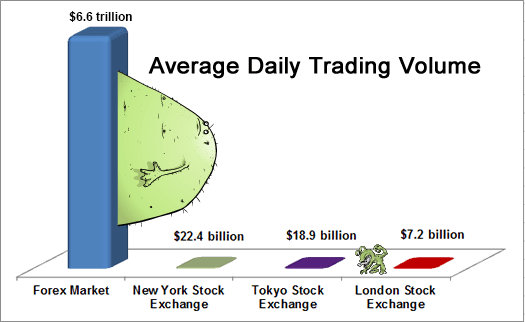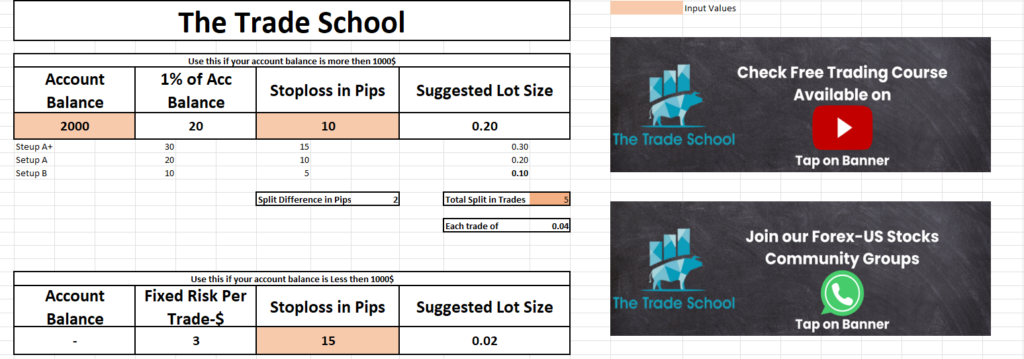How to Start Forex Trading? The most searched sentence on Google. also known as foreign currencies and commodities exchange trading, involves the buying and selling of currencies and commodities on the foreign exchange markets to make a profit. It is the largest and most liquid financial market, with an average daily trading volume of more than $6 trillion. Forex trading offers the opportunity to participate in the largest trading market and potentially generate income from swing, active, scalping, and positional trading. The best way to learn forex is to be a part of our trading community, by joining our Free WhatsApp Groups.
Forex Trading Overview:
It is the largest and most liquid financial market globally, where different currencies and commodities are traded 24 (Technically 22 Hours) hours a day, 5 days a week. It operates through a decentralized network of banking institutions, financial institutions, corporations, governments, and individual retail and HNI (high net worth individual) traders, with no central exchange or physical location. The Forex Market starts its day from Sydney Australia and ends the day with the closing bell of the US Stock Exchange. The main objective of the forex market is to facilitate currency conversion and international trade. For Joinning our Forex Trading Course click here.
Key Features of the Forex Market:
- High Liquidity in the Forex Market: The forex market’s size and scope makes it highly liquid among all the other financial markets, meaning there are too much opportunities to enter and exit from trades without significant price movements and time.
- Global Participation: Forex Market is accessible to retail and institutional traders worldwide, allowing participation from any location with an internet connection and smart device. This accessibility contributes to the market’s continuous operation across different time zones 24 hours and 5 days in a week.
- High Leverage: Forex trading offers retail and institutional traders the ability to trade on margin technically too much margin if we compare forex with other financial market, allowing them to control larger positions with a relatively small amount of investment. While leverage can amplify profits, it also increases the potential for losses means either you will make more or you will lose all of your account balance, 100% risk on investment, emphasizing the importance of risk management.
- Small and Big Participants: The forex market caters to a wide range of market participants, including but not limited to central banks, commercial banks, hedge funds, multinational corporations, retail traders, and speculators. Each participant plays a unique role in influencing the currency and commodities prices and market sentiments.
- High Forex Trading Volume: The forex market boasts an average daily trading trading volume exceeding $6 and a half trillion but the volume is not 100% accurate as market is decentralized, we mostly use tick volume in forex not real volume, making it significantly larger than other financial markets such as stock market, bond markets and other financial markets. This high trading volume contributes to market formation.

Trading Instruments in the Forex Trading:
In the forex trading world, traders buy and sell (technically trade) currencies in pairs not a single like stocks, where one currency is exchanged for another like you buy Euro in exchange of US Dollar. Each currency pair consists of a base currency and a quote currency like EURUSD EUR is the base currency and USD is the quote currency, and the exchange rate represents the price at which the base currency can be exchanged for the quote currency, Current rate of EURUSD is 1.0772. (Note rate change on the daily basis) for realtime quote click here.
Major Currency Pairs:
- EUR/USD (Euro/US Dollar): The most traded currency pair, representing the eurozone’s euro against the US dollar. this is most trade able instrument in the forex. EURUSD current exchange rate is 1.0772.
- USD/JPY (US Dollar/Japanese Yen): The second most traded currency pair, representing the US dollar against the Japanese yen. USDJPY current exchange rate is 155.78.
- GBP/USD (British Pound/US Dollar): Known as “Cable,” it represents the British pound against the US dollar. click here for current exchange rate.
- USD/CHF (US Dollar/Swiss Franc): Represents the US dollar against the Swiss franc.click here for current exchange rate.
- AUD/USD (Australian Dollar/US Dollar): Represents the Australian dollar against the US dollar.click here for current exchange rate.
Minor and Exotic Currency Pairs:
- Minor Pairs: Currency pairs that do not include the United State dollar in the pair. Examples include EUR/GBP (Euro/British Pound) and GBP/JPY (British Pound/Japanese Yen). click here for current exchange rate.
- Exotic Pairs: Currency pairs that involve one major currency and one currency from a smaller or emerging market economy. Examples include USD/TRY (US Dollar/Turkish Lira) and EUR/TRY (Euro/Turkish Lira). click here for current exchange rate.
Cross Currency Pairs:
- Cross Pairs: Currency pairs that do not involve the US dollar. Examples include EUR/JPY (Euro/Japanese Yen) and GBP/JPY (British Pound/Japanese Yen). click here for current exchange rate.
Conclusion
Starting forex trading requires patience emotion less trading, dedication never give up mindset, and continuous learning, keep updating yourself day by day. By understanding the technical and fundamentals of forex trading, choosing a reliable broker is not a easy task, developing a solid trading strategy, either it’s based on Volume Spread Analysis VSA and any Price Action Trading, check below Volume Analysis lntro lecture and practicing disciplined risk management (use our Risk Management File), you can increase your chances of success in the forex market. Remember that forex trading involves inherent risks, there is a highly chance that you will lose 100% of your capital, and it’s essential to trade responsibly and only with funds you can afford to lose.


